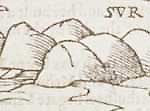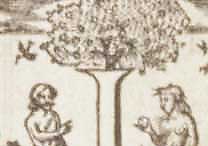During the sixteenth and seventeenth centuries, there was an increasing demand for vernacular translations of the Bible. This was stimulated by the writings and teachings of humanists and reformers, and sustained by the doctrines and liturgies of the new Protestant churches. Reformed church services assumed the provision of copies of the scriptures in the vernacular, so that the text of the set lessons could be read aloud to the people. Individuals purchased copies of the Bible in a wide variety of styles and sizes, for reading aloud to their families at home, for private study, or as pocket books which could accompany them to sermons and lectures. In several countries, political and ecclesiastical authorities sought to control the theological consequences of the demand for the scriptures by sponsoring official, national translations. One of these was the Authorized Version of the English Bible, produced by committees of learned translators, and first published in 1611.

|
|
|
catalogue no. 4
|
Over the course of the seventeenth century, editions of the Authorized Version eventually displaced alternative English translations, such as the Geneva version (catalogue no. 4 ), from the market. The longevity and success of the Authorized Version was not inevitable. During the 1650s especially, its critics mounted a series of attempts to have the English translation altered or replaced. Some wished to see it provided with additional notes, to aid interpretation by the individual reader; others wished to amend the text or even translate it again from the original languages. Although the Authorized Version was confirmed as the standard English translation of the Bible after the restoration of the monarchy and the Church of England in 1660, the arguments used by its critics were not entirely the product of radical or sectarian discomfort with an official text. Much of the language of the Authorized Version was drawn directly from the first published English Bibles, translated in the 1520s and 1530s by William Tyndale. A good deal of this seemed archaic or even incomprehensible to readers and hearers of the mid-seventeenth century. Furthermore, there were places where the Authorized Version mistranslated passages or where scholarly advances made the choice of words seem ill-judged. It was also a fact that the Authorized Version was shaped to the doctrinal assumptions of the Church of England, which were heavily criticized during the period of the Civil Wars and Interregnum in the 1640s and 1650s. There was, then, an argument for the revision of the Authorized Version, which appealed, for example, to some of Samuel Hartlib’s friends. However, at the Restoration, that case was generally rejected as showing contempt for authority.
Despite its popularity, the Bible remained an expensive book for much of the seventeenth century. In part, this was because it was a large work, which required the use of a lot of paper – normally the most expensive component of the early modern book. Its production was complicated by the theological demand that its text be printed to a very high level of accuracy, in order not to mislead readers who had been taught that their religion was founded on the literal interpretation of scripture. This requirement was often used as an excuse to defend the monopoly of the King’s Printers over the publication of the Bible, in particular the Authorized Version. Although it was not unusual for the right to publish steady-selling books to be vested as a monopoly in the hands of small groups of booksellers and printers, each holding a share in the copy, in the case of the Bible the practice did generate occasional controversy. Objections were raised against profiteering and it was sometimes argued that competition would improve the quality of printing, as well as lowering the price of the book. In the late 1620s and 1630s, the University of Cambridge embarrassed the King’s Printers by exercising its right to print folio Bibles and by the high quality of its work (see catalogue no. 3 ).

|
|
|
catalogue no. 3
|
However, real attempts to break into the King’s Printers’ monopoly, by produ cing rival editions of smaller format Bibles, only became possible with the breakdown of the authority of the Crown and of the Stationers’ Company during the 1640s. Then a number of printers brought out alternative editions of the Authorized Version, and prices fell dramatically. Unfortunately, quality was often sacrificed, and worries also surfaced about the increasing spread of pirated editions of the Bible, especially those imported from Holland. Following the Restoration, the King’s Printers came to arrangements with some of their rivals and were largely successful in reasserting their rights, although they had to fight off a serious challenge from the Oxford University Press in the 1670s and 1680s. Despite the survival of the monopoly, Bibles did become more affordable than they had been in the 1630s, in part because of a trend towards the production of smaller books printed on poorer paper. At the end of the seventeenth century, when wages were also higher, a standard, octavo edition of the Bible might have cost four shillings (unbound), compared with a price of more than six shillings in the 1630s.
The Bibles represented here range from the very grand to the relatively humble. The Bible was an essential part of the personal property of devout men and women, and individual copies often reflected the taste, wealth, and piety of their owners. These factors often shaped the choice of format, which could also be affected by the use to which the owner intended to put the book. They certainly determined the binding of the Bible (catalogue no. 8 , for example), which was frequently a much greater expense than the purchase of the book itself.
Most of the Bibles described here could be illustrated with separately-purchased engravings. Several London printsellers stocked series of cuts for binding up with Bibles, and such pictures were intended to bring out the narrative elements of scripture in much the same way as the chapter headings printed in the text. They were clearly objects of delight as well as of instruction, and seem to have been particularly popular with wealthy female readers, and perhaps also with the purchasers of Bibles intended as gifts for children. Their presence in copies of the Bible was, however, exceptional. In the middle years of the seventeenth century, most people would have read the plain text of scripture, and, for reasons of theology, would probably not have wanted anything more. Children were brought up to read the historical narratives of the Old Testament first of all, perhaps initially picking up the thread from the chapter headings. This inculcated a sense of the Bible as exemplary story and as historical truth which never left most people.

